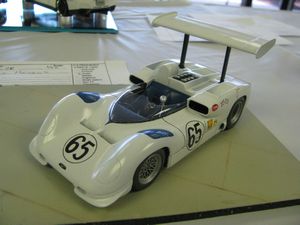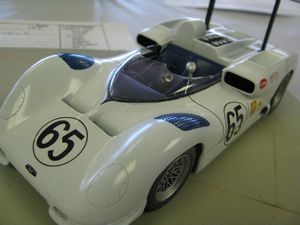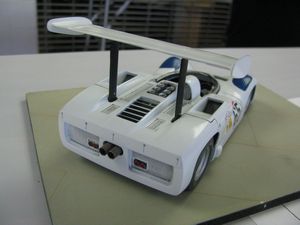















Chaparral 2E |
|---|

|
| Topic Navigation |
|---|
|
Wikipedia: Chaparral Cars: 2
Page Sections History Photographs |
History
The following section is an excerpt from Wikipedia's Chaparral Cars page on 25 May 2016, text available via the Creative Commons Attribution-ShareAlike 3.0 Unported License.
Background
Troutman and Barnes were builders of the original Chaparral race cars (later referred to as Chaparral 1). Jim Hall purchased two Chaparral 1s to race. When Hall and Sharp began building their own cars, they asked Troutman and Barnes if they could continue to use the Chaparral name. That is why the Hall/Sharp cars are all named Chaparral 2s (models 2A through 2J for sports cars/CanAm cars, and the 2K which was the 1979–1982 Indycar).
2
The first Chaparral 2-series was designed and built to compete in the United States Road Racing Championship and other sports car races of the time, particularly the West Coast Pro Series races that were held each fall. Hall had significant "under the table" assistance from GM, including engineering and technical support in the development of the car and its automatic transmission (this is evidenced by the similarity between the Chevy Corvette GS-II "research and development" car and the Chaparral 2A through 2C models).
First raced in late 1963, the Chaparral 2 developed into a dominant car in the CanAm series in 1966 and 1967. Designed for the 200 mile races of the CanAm series, it was also a winner in longer endurance races. In 1965 it shocked the sportscar world by winning the 12 Hours of Sebring in a pouring rain storm, on one of the roughest tracks in North America.
The Chaparral 2 featured the innovative use of fiberglass as a chassis material. The Chaparral 2C had a conventional aluminum chassis.
It is very difficult to identify all iterations of the car as new ideas were being tested continually.
The 2E was based on the Chevrolet designed aluminum 2C chassis and presented Hall's most advanced aerodynamic theories to the racing world in the 1966. The 2E established the paradigm for virtually all racing cars built since. It was startling in appearance, with its radiators moved from the traditional location in the nose to two ducted pods on either side of the cockpit and a large wing mounted several feet above the rear of the car on struts. The wing was the opposite of an aircraft wing in that it generated down-force instead of lift and was attached directly to the rear suspension uprights, loading the tires for extra adhesion while cornering. A ducted nose channeled air from the front of the car up, creating extra down-force as well. By depressing a floor pedal that was in the position of a clutch pedal in other cars, Hall was able to feather, or flatten out, the negative angle of the wing when down-force was not needed, such as on a straight section of the track, to reduce drag and increase top speed. In addition, an interconnected air dam closed off the nose ducting for streamlining as well. When the pedal was released, the front ducting and wing returned to their full down-force position. Until they were banned many sports racing cars, as well as Formula One cars, had wings on tall struts, although many were not as well executed as Hall's. The resulting accidents from their failures caused movable wings mounted on the suspension, as well as movable aerodynamic devices, to be outlawed.
The 2E scored only one win, at the 1966 Laguna Seca Raceway Can-Am with Hill driving. Hall stuck to an aluminum 5.3 liter Chevrolet engine in his lightweight racer, while the other teams were using 6 to 7 liter iron engines, trading weight for power.
The 2E was a crowd favorite and remains Hall's favorite car.
 |
Subject: Chaparral 2E Scale Model
Photographer: Bill Crittenden Event: 2010 NIMCON Model Build Info: Fisher Models kit. View photo of Chaparral 2E Scale Model Car - 4,141KB |
 |
Subject: Chaparral 2E Scale Model
Photographer: Bill Crittenden Event: 2010 NIMCON Model Build Info: Fisher Models kit. View photo of Chaparral 2E Scale Model Car - 3,973KB |
 |
Subject: Chaparral 2E Scale Model
Photographer: Bill Crittenden Event: 2010 NIMCON Model Build Info: Fisher Models kit. View photo of Chaparral 2E Scale Model Car - 3,833KB |
